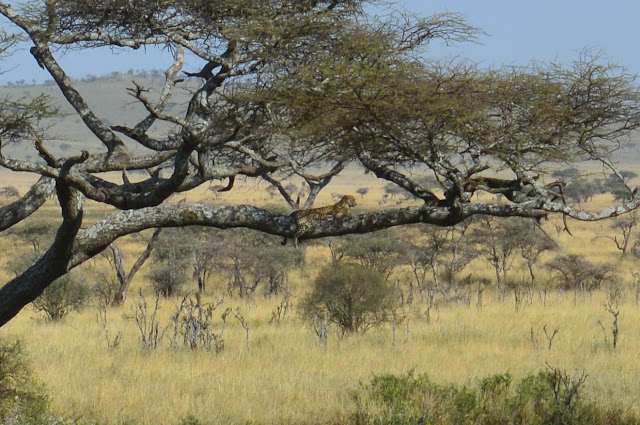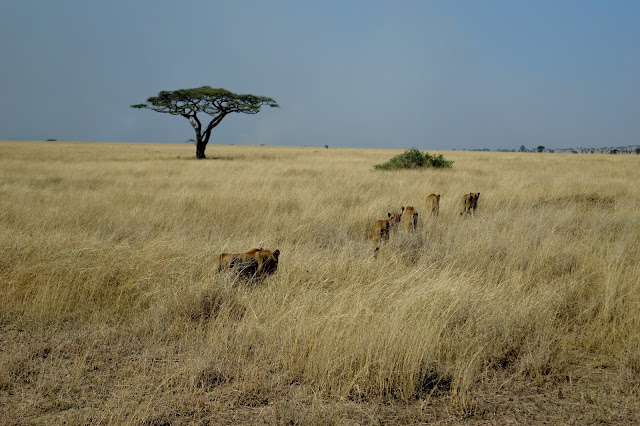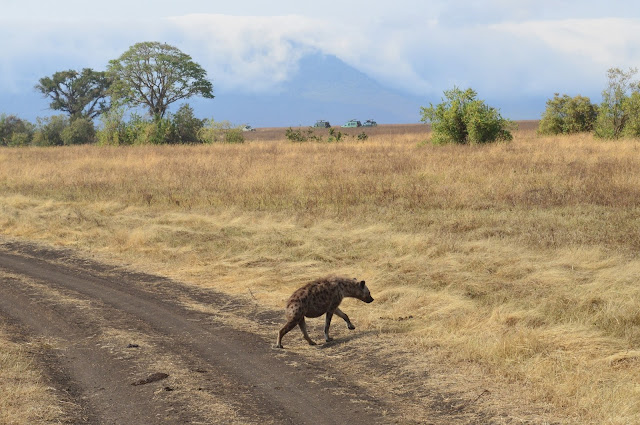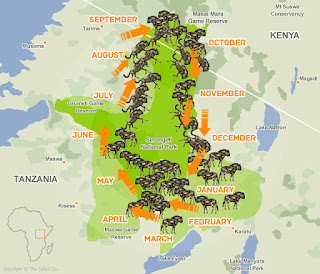Together, Serengeti and Maasai Mara hosts the largest terrestrial mammal migration in the world, which help secured it as one of the Seven Natural Wonders of the world. Serengeti is derived from Maasai language, meaning 'Endless Plain'. The park is around 14,763 km square in area, and lies in a high plateau between Ngorongoro highlands and extends almost to lake Victoria to the east. Northern part of the plain in Kenya called Maasai Mara, which is roughly 1,500 km square, or 11% of Serengeti's area. The Serengeti is also well known for its large lion population and is one of the best places to observe large prides in natural environment.
|
Wildebeest Mara River Crossing, Maasai Mara |
The Serengeti, like most of East African, is part of a plateau which is well above sea level. The basements of the plain were formed by hard rocks, covering by shallow soils mainly comprised of volcanic ash derived from a number of local volcanoes. Depth and type of soil defined the vegetation of the plain. Soils on the north-eastern Serengeti are highly saline, and alkaline, and are also too shallow to grow trees. Consequently, southeastern plains are treeless open grassland. Soil catena towards south-eastern part of Serengeti gradually changing to deep, silty, poorly drained soils, and the woodlands starts at a sharp boundary running south & east of Seronera.
|
Open Grassland vs. Extensive Woodland, Serengeti
Serengeti, Maasai Mara, Ngorongoro conservation area, and several other game reserves formed the Serengeti ecosystem, defined by the dominate migration route of wildebeests, and extended to surrounding areas. Much of the wildlife which inhabits the area moves clockwise along park boundaries the certain season of the year to follow the rainfall and resulting water & food.
... and Ngorongoro Crater is just tremendously beautiful. Wish I had better lens.
The herbivores population of Serengeti ecosystem mainly composting of:
Major predators include:
All members of 'African Big Five' (Lion, Leopard, African Elephant, Black Rhinos and Buffalo) are found in Serengeti-Mara plain. Details please see my post ' The African Big Five'. |
|
|
|
Lion Pride, Serengeti
Ostrich youth group, Ngorongoro conservation area:
|
|
Route and schedule of Great Wildebeest Migration |
The wildebeest spend rainy season from December to June in the open plains below Ngorongoro crater where grass growth is most productive and nutrient contents high. Calves are born here. In a period of only few weeks around 90% of cows dropped the calves, preferably on the short grass land. Calves can stand within 7 minutes on average and remain with and dependent on their mom for at least 6 months. Calves grow to strong and hard to catch only in 2 days, and after that even the spotted hyena, the main wildebeest predator, seldom bother with them. The wildebeest unusually short calving season seems designed to surfeit predators at one time but not give them a steady supply of calves throughout the year, minimizing the calves loss. The wildebeest is one of the few African antelopes to have extended its range in the last 50 years. They numbered about 250,000 in 1960 and are thought to number 1.6 million today
In June, when the long dry season begins in Serengeti, wildebeest start gathering and moving off the plain, heading southwest, north or west to follow the rainfall. Everyone who got the chance to see nearly two millions animals on the move has been touched by the magic of this land. Lines of wildebeest up to 40 km long have been observed before.
|
Migrating wildebeests, mixed herd with zebras, Maasai Mara |
Wildebeests are usually herd with zebras and gaze different parts of the same grass. Wildebeest are short grass grazers, their mouths are shaped so they can grip the juicy shoots. Zebra have long front teeth and can sheer off the long grass. A Zebra will move into an area of long grass before other herbivores and eat grass down to allow for new growth that is suitable for Wildebeest.
Zebras play an important role in wildebeest migration. If you ever conduct research on great migration, you probably noticed that quite often the migrating herds of wildebeests are following a few leading zebras. Zebras are highly intelligent animals. They have good memories and can remember the direction of the migration, best places to cross the rivers etc. Wildebeest tend to just jump in and hope for the best, which is why they are often an easy target for the hungry crocodiles. Zebra will watch a small group of individuals cross safely before they all charge in. So it's beneficial for wildebeest to be on the march with zebra since they are more careful travelers.
Zebras also benefit from this symbiotic animal relationship as wildebeest are able to help locate the water. Wildebeest need to drink at least every other day so they have an overdeveloped sense of smell for it. Given how dry the Serengeti looked just after the rainy season already, it's obviously a very beneficial thing to have friends who know how to sniff out a drink.
Scientists also believe that Zebras have better eyesight and hearing so they are quicker to sound the alarm when a lion or hyena comes prowling around. Because of relatively poor eyesight, wildebeests often commingle with zebras to take advantage of the zebras' visual acuity. Interestingly, wildebeest often string out in long single columns when on the move, which sometimes last tens of kilometers long, believed due to wildebeests' visual constrain :)
|
Wildebeest string out in long single columns when on the move, Ngorongoro Crater |
This cooperation sometimes goes beyond for the goodness of individual but for all. It was reported that in Ngorongoro Crater park, a male zebra driving away a hyena that was chasing a wildebeest calf, while the wildebeest looked or ran the other way. Fairly interesting story.
There is little chance a wildebeest is dying of old age. About 250,000 wildebeests die during the annul migration from Serengeti in Tanzania to Maasai Mara in Kenya. Vast majority of the death caused by thirsty, hunger, exhaustion, or predation.
It has been long argued on what triggers the migration. General belief is the rainfall, that wildebeests are able to smell the rainfall over a long distance, some fifty kilometers away; and to survive, they need to follow the rain. While this doesn't explain why quite often the migrating herds of wildebeests are following a few leading zebra. How did zebras know the approximate route of the migration? But the route is changing, influenced by the actual rainfall pattern. The Serengeti still has a lot more questions than we can produce answers.
The Mara River Crossing
Wildebeests crossing Mara River is the most dangerous yet exciting part of their 3,000 km annual migration as exceptionally large Nile crocodiles are lying in wait. Drowning and over crowding also take lives. This river gushes through the northern Serengeti from Kenya's adjacent Maasai Mara Game Reserve. Mara River crossing is a must for wildebeests to complete the migration and it is one of the highlights as the animals try and cross the Mara River alive.
I was one of the lucky few who witness the wildebeests crossing, which happened on Aug 25, 2015 in Maasai Mara, when a large family unit was trying to move off Mara conservatory and enter Mara triangle. It's a breath taking moment, it is incredible, magic, indescribable, and it is absolutely a once in a lifetime experience!
We arrived at Mara River at noon hours from the Mara Conservatory side. Large herds of wildebeests gathered on the edge of river, looks like a family unit of thousands, signaling that a crossing is possibly going to occur. People call this 'building'. Safari guides in Maasai Mara use handheld transceiver to notify each other the appearance of a rare sight; So bunch of vehicles rush there to see if a crossing will happen. We probably are the last one to arrive, and when we get there almost 20 other vans were waiting already. But there are no guarantees when it comes to a crossing. Sometimes the herd congregated and then, for some inexplicable reason, decided not to cross and turn around. You may wait for hours and nothing happens, but when it does, it's magical. Exciting guides and tourists were waiting anxiously for the thrilling show.
後麵的貼不上了,去我的博克看吧: http://chinadiansalmon.blogspot.com/2015/09/serengeti-maasai-mara-and-great.html




